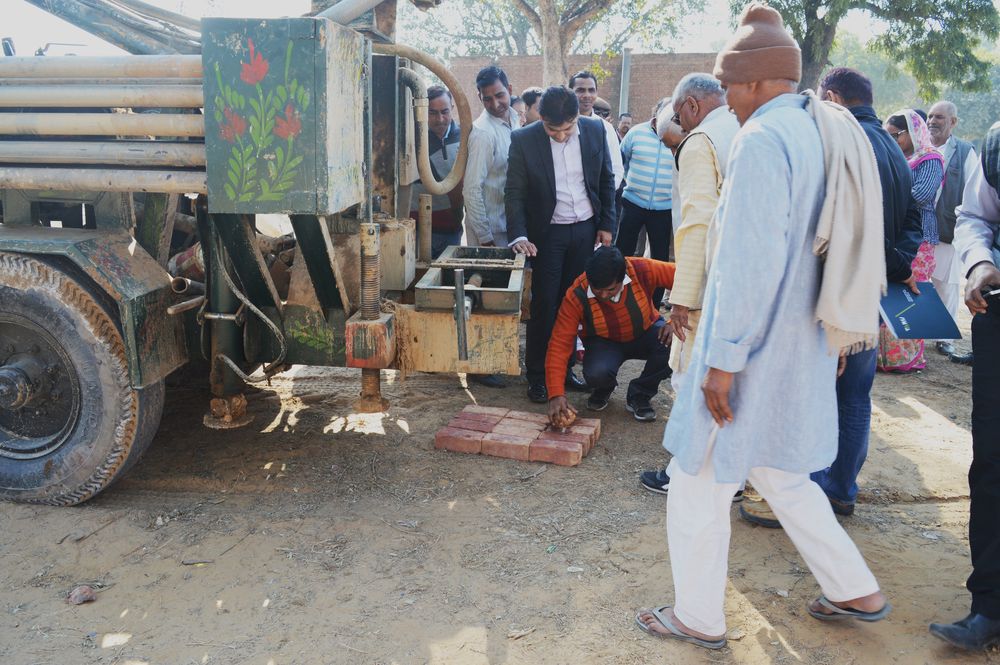Background
National Capital Region (NCR) Delhi is a water scarce region, largely dependent on groundwater and surface water resources located outside the region. Water stress in the peri-urban areas in NCR Delhi is even grimmer due to insufficient infrastructure and physical development. Rising population, increasing water demands for domestic and industrial uses and dwindling local sources of water have compounded the problem. Although certain agencies have stepped in to minimise the distress and started funding solid and liquid waste management projects in the region, they somehow could not reach the expected progress due to lack of clear guidelines on taking it forward and insufficient seed funding.
The selected village, Garhi Harsaru located in Gurgaon Tehsil in Gurgaon District of Haryana state is one out of the many water stressed peri-urban areas in Delhi NCR. As per the Census of India 2011, the village comprises of 598 households with 3,140 population. The action research showcased that groundwater is the single source for meeting all the water demands of the village, both domestic as well as agricultural. Although, there are three ponds in the village, two of these are on the verge of extinction as a consequence of encroachment on inflow channel and the pond by the inhabitants while the third is contaminated with wastewater from the village.
Existing water harvesting mechanism in the village
There is no formal mechanism for rainwater harvesting and following the natural drainage patterns, the rainwater escapes to the fields, the village pond, percolated and some stagnates in the puddles. The village groundwater table is lowering and as a result, tube wells, hand pumps, borewells and even piped water supply started yielding saline water. The water supply through public water system is irregular and this inadequate and inefficient Piped Water Supply (PWS) forced villages to rely on individual borewells.
The project
In 2015, India Water Partnership (IWP) in collaboration of TARU Leading Edge - New Delhi have started the project "developing a detailed project report on Integrated Water Resources Management (IWRM) for the village Garhi Harsaru, Gurgaon". The project taken a phased approach; the action research phase and development of a Detailed Project Report (DPR) on IWRM, resource mobilisation and implementation.
At the first phase, TARU Leading Edge collaborated with Sehgal Foundation and Indian Green Services (IGS) have developed a comprehensive framework/Detailed Investment Plan (DIP) for village Garhi Harsaru for sustainable development and management of its water resources. The framework highlighted the main areas that the investment should be directed, in which an effective legal and institutional framework for its implementation needs to be established. The suggested IWRM approach consisted of three facets,
- Safe Drinking Water
- Proper disposal of waste (both solid and liquid)
- Sanitation and good hygiene practices
Working in progress rainwater harvesting (RWH) systems
The actions research observed that introducing surface or rainwater management to villages would be beneficial as the villages have not yet embraced any type of water harvesting measures. Therefore, rooftop rainwater harvesting and surface runoff water harvesting were identified to achieve ground water recharge and solid and liquid waste management in the DPR.
Since most of the schools in the village do not have a reliable source of water for drinking and sanitation, the proposed RWH structures will be a good source of water to fulfil the for daily requirement. Furthermore, they seek to provide a source of water for household requirements, such as hygiene and sanitation purposes and the treated water can also be considered for use for drinking. Most importantly, RWH tanks are the best remedy for aquifer recharging.
Resource mobilisation
With the detailed IWRM project report and investment plan in place, IWP along with TARU Leading Edge reached out the cooperate sector in India in 2017 for fund raising and are awating for their positive responses. In the meantime, the team also conducted meetings with the local authorities to obtain support and raised awareness among schoolchildren on WASH within the year.
On 16 January 2018, IWP in collaboration with TARU Leading Edge kick-started the project, by laying the foundation for constructing a RWH structure at the Senior Secondary Government School, Garhi Harsaru in Gurgaon. The constructions started with a Bhumi Pujan (an Indian traditional ritual performed before damaging to earth and constructing structures) at the school premises with the presence of local government authorities, high level officials from the cooperate sector, officials from IWP and TARU, and the community. IWP launched the project in view of demonstrating the benefits to the potential donors and to draw their attention for collaboration and financial assistance.
Local government and the community are involved in constructing the RWH structure with the technical backing of TARU Leading Edge. The whole school having nearly 1,000 students will be benefitting out of this project while the rest of the community in the village Garhi Harsuru will be benefitted through the recharged ground water.
